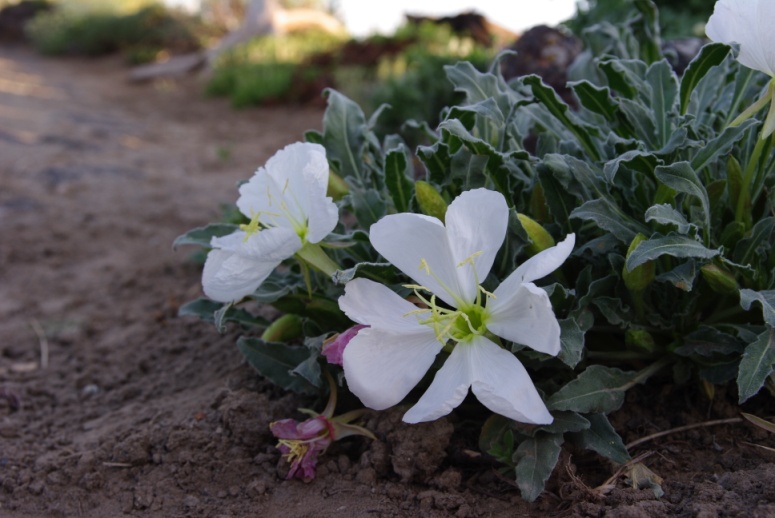Tufted Evening Primrose in the Landscape

Stephen Love, University of Idaho
Scientfic Name: Oenothera caespitosaCommon Name: Tufted evening primrose, fragrant evening primrose
Description: Tufted evening primrose is an herbaceous, moderately long-lived perennial. Foliage is basal, and mature plants are typically 6 to 10 inches tall and up to 2 feet wide. Individual plants range in form from matted to mounding. Leaves are long, lobed or toothed, narrowly spoon-shaped to nearly linear, gray green in color, and covered with short hairs. Flowers are very large and bright white. Blooms last for a single day, open in the evening, are pollinated at night by hawk moths, then fade to pink and wilt the next morning. A continuous supply of new buds extends the bloom season across much of the summer. Some forms of the plant can be strongly rhizomatous and invasive. Non-invasive forms of tufted evening primrose make good subjects for xeric rock gardens, low beds, or borders.
Native Habitat: Oenothera caespitosa is a widespread species of the western half of the US. It grows in a range of soil types and plant communities, but most commonly inhabits sites where shallow soils or low water availability limits the size of competing plants. Tufted evening primrose is found at elevations ranging from 3,000 to 10,000 feet.
Cultural Requirement
Soil: Tolerates a wide range of soils, including clay and those with high pH, but requires a dry site or well-drained conditions to ensure a long life span.
Moisture Tolerance: Thrives under very dry to moderately dry conditions. Bloom period is extended with occasional supplemental irrigation.
Sun/Shade/Preference: Prefers full sun but grows well and blooms adequately in light shade.
Transplanting: Young seedlings transplant easily, both from pot to pot and from pot to garden. A stable root ball is preferred when planting from pot to garden. Larger plants do not survive well if transplanted bare root. Can withstand long-term culture in pots up to 1-gallon size. Plants grow fairly rapidly after transplanting and bloom abundantly the first year.
Propagation: Best grown from seed. Requires 8 to 12 weeks of cold stratification to optimize germination. Typically produces a high rate of germination. Once emerged, seedlings are easy to handle and transplant nicely when they have 3 to 4 true leaves. Plants can also be propagated by division or root cuttings held under mist.
Maintenance (pruning, fertilization, deadheading, division, irrigation, etc): Tufted evening primrose is almost maintenance free. Remove old leaves in the spring. Spent flowers are self-cleaning and no dead-heading is required. Apply 2 to 4 supplemental summer irrigations to extend the bloom period. Added fertilizers are seldom required.
Insect, disease, or other problems: Diseases rarely or never infect tufted evening primrose. Unidentified beetles occasionally chew shot holes in the leaves, but do not require control measures. Unidentified caterpillar larvae may feed on and damage the flower buds and may need to be controlled if present in high numbers.
Landscape Value
Use in the Landscape: Tufted evening primrose can be used effectively with other short-statured plants to create attractive xeric rock gardens, beds, or borders. This plant is amenable to use in either formal or naturalized designs and can be incorporated almost anywhere a small, continuously flowering plant is required.
Weediness/Invasive Potential: Some forms of tufted evening primrose are aggressively rhizomatous and invasive in the landscape, often spreading 6 or more feet in a single season. In order to ensure appropriate garden behavior, it is critical to select plants from populations with minimal potential for spread. This species consistently produces a low number of volunteer seedlings. These are not difficult to control.
Foliage: Leaves are all basal and grow from short caudices. Leaves are narrow, spoon-shaped or linear, up to 10 inches long, gray-green in color, either lobed or toothed, and covered with short hairs. Foliage remains attractive season-long.
Flower: The 4-petalled flowers are large, white, and showy. New blooms open in the evening and last for less than a day. Flowers fade to attractive shades of pink after pollination. Plants produce a continuous supply of new buds for as long as conditions allow.
Timing: May-August.
Fruit: The fruits are long, pointed, woody capsules. Each contains numerous oval black seeds.
Form: Most garden-worthy selections of tufted evening primrose have mounded form both prior to and during bloom. Rhizomatous types of the species may have a more mat-like form.
Texture: Moderately coarse.
Ultimate Size: Non-rhizomatous plants are typically 6 to 10 inches tall and up to 2 feet wide. Rhizomatous plants may be shorter and much wider.
Rate of Growth: Tufted evening primrose plants are relatively fast growing and develop an attractive leaf mound within a few months. They usually bloom profusely the first year after transplanting to the garden.
Suggested Plant Partners: Plant tufted evening primrose in rock gardens and low beds or borders with other colorful, short to medium-sized wildflowers, including Phlox colubrina, Townsendia parryi, Penstemon ramaleyi, Hymenoxys acaulis, Agastache cusickii, Eriogonum ovalifolium, Eriogonum brevicaule, and Allium obtusum.
Availability: Occasionally available as potted plants from local or mail-order nurseries specializing in native plants. Seed can be purchased from native plant seed suppliers.
Cultivars: None.
References:

